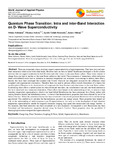| dc.contributor.author | Otimo, Solomon | |
| dc.contributor.author | Sakwa, Thomas | |
| dc.contributor.author | Ayodo, Yuda Kennedy | |
| dc.contributor.author | Sifuna, James | |
| dc.date.accessioned | 2017-03-01T23:22:23Z | |
| dc.date.accessioned | 2017-09-22T11:54:58Z | |
| dc.date.available | 2017-03-01T23:22:23Z | |
| dc.date.available | 2017-09-22T11:54:58Z | |
| dc.date.issued | 2017-01-18 | |
| dc.identifier.uri | http://hdl.handle.net/190/330 | |
| dc.description.abstract | There are compounds whose structures support superconductivity at high temperatures. They have intra and inter-band interactions which occur within their bands. However there has been no hybrid Hamiltonian developed so far for a lattice structure that can support conduction by both D-waves and other waves on the same Fermi surface. These waves interact or change from one type to another on the same Fermi surface as they travel. The occurrences of interactions within and across bands with different waves lead to variations in transition temperature and resistance. In an attempt to address these effects, theories that have been developed that consider only S-wave which do not adequately account for the differences when compared with experimental observations. Therefore there was a need to advance efforts towards formulation of a theory that would explain differences in the characteristics of compounds that have D-waves and other waves on the same Fermi surface. In advancing these efforts a hybrid system has been developed that takes into consideration intra and inter-band interactions that have introduced new interaction dimensions. These efforts have helped in the understanding of how to achieve a high transition temperature superconductor, which a two band hybrid Hamiltonian has been determined for a Fermi surface with varying fermions density and hybridization terms. It is from it that thermodynamic properties have been obtained by use of the Green’s function. Where the correlation function has been substituted in the second quantized Hamiltonian form and the energy gap derived. This enabled us to calculate the thermodynamic potential and energy density. These properties have helped not only in the understanding of multi-component type II superconductors, but more so in the development of high transition temperature superconductors needed for magnetic resonance imaging, high speed data transmission and energy transfers. In this research, inter-band interaction has been considered on a new dimension. Consequently a new Hamiltonian has been formulated and thermodynamic properties derived using the Green’s function. These properties show the possibility of attaining high transition temperature superconductivity. | en_US |
| dc.publisher | Science Publishing group | en_US |
| dc.subject | Energy Gap, Phase Transition, Coupling, D-Wave, Hybrid, Superconductivity, Hamiltonian | en_US |
| dc.title | Quantum Phase Transition: Intra and Inter-Band Interaction on D- Wave Superconductivity | en_US |

